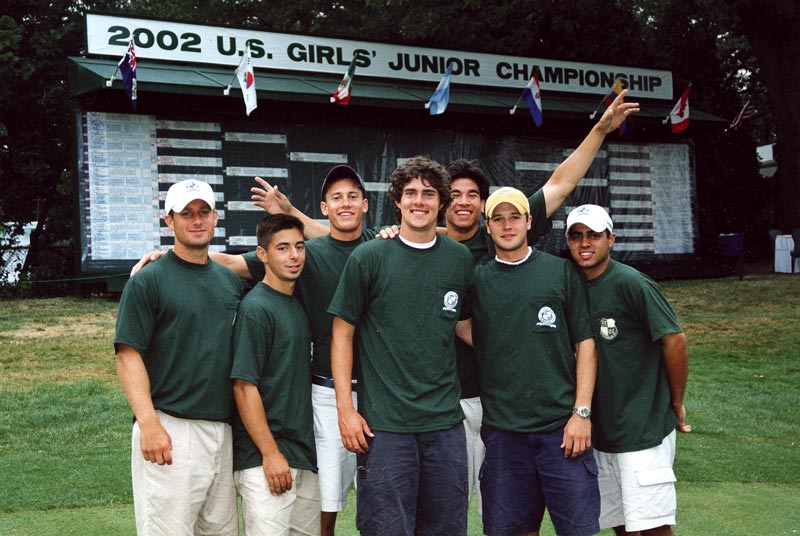
Photo by Montana Pritchard
Seven years ago, I began teaching planning and budgeting at the Rutgers Professional Golf Turf Management School. I found that my students were not just interested in the day-to-day care and maintenance of turf, but that they enjoyed my “war stories” and the insights I had gained from 30 years in the golf business.
At their request, I presented after-hours lectures on career building, and from those sessions came a new unit in the Rutgers University program titled “Professional Development.” The following are some key points from those lectures — points I wish my professors had told me three decades ago when I was in school. Some have to do with applying for your first job, and others pertain to holding more responsible positions as your career develops.
1. How to build your career
Some of the most important choices you make in our business come early in your career. Critical evaluations for potential young superintendents include deciding where to work and for whom, assessing what you will learn there and whether that knowledge will help grow your career, and determining when it’s time to move on to a different club for another work experience.
It’s important that your first few work experiences are more than just jobs — they need to be positive apprenticeships that will expand your knowledge and résumé, challenge you, and better prepare you for your next position.
For example, when contemplating a position as an assistant superintendent, find out how many superintendents have come through the assistant ranks at that club and, by talking to those former assistants, find out what the work experience was like. Your boss should not only support your career goals, but should also play an active part in guiding you and furthering your personal and professional growth. He or she should do everything possible to help you obtain interviews when opportunities become available.
Your boss should be a mentor, and your decision on employment ought to be based much more on this factor than on pay or geographic convenience. If made thoughtfully, these early decisions will have a long-term positive effect on your career.

Author Chris Carson had a student who interned at St. Andrews Golf Club in Scotland, where he helped rebuild several stacked-sod bunkers. Carson advised him to highlight this in his résumé and cover letter to stand out from other job candidates. Photo courtesy of Chris Carson
The club where you work is as important as who you work for. Working at a famous club, at a grow-in or at a club preparing for a championship can make your job much more important and much more valuable to you in building a career. Working at a club with high standards and superior quality will teach you what it takes to achieve a high level of maintenance, and this knowledge will serve you throughout your professional journey.
Most important, envision the job you ultimately want and figure out the work history, education, skills and contacts you will need to get that job. This personal career plan will help you make decisions on job opportunities throughout your career. Refer to your plan and ask yourself, “Will this job — and this person — help me progress toward my ultimate goal?” If the answer is no, it’s probably the wrong position for you.
2. How to set yourself apart
The best cover letter I ever received from a potential assistant listed in the first paragraph several accomplishments that were pertinent to the position. In the next paragraph, he wrote, “But I am sure that many other applicants have similar qualifications. What sets me apart is ...” He then discussed his military service and why that made him a superior candidate.
This told me the applicant was aware there was competition, that I was looking for reasons to separate résumés, and that he had a particular skill worth mentioning. It showed a keen understanding of the process I was going through, and it encapsulated the way to success in our business: You must find a way to set yourself apart from other applicants.
If you have distinctive talents and you package them in such a way as to make yourself an appealing candidate, your cover letter will function as an effective sales tool. You are offering yourself as a qualified individual with skills unique to you.
3. How to make a targeted work portfolio
During your years as an assistant, you will have an opportunity to amass a stockpile of photographs of projects, successes, failures, disease problems, equipment, etc. This photo bank can be a valuable tool when applying for a job.
Touring the course where you are applying prior to an interview will allow you to photograph what you perceive to be course problems. If you then assemble a portfolio of similar problems you’ve encountered and describe how you solved them, you’ll exhibit leadership and say the following:
- You are an organized individual with good communication skills.
- You have identified areas of concern on the course that you have experience in addressing, and you have viable solutions.
- You may be able to identify problems the interview committee did not know existed.
This is a great opportunity to show that you have a solid knowledge base and that you are the person they’ve been looking for — someone with a vision for how to take their course to the “next level.”
4. How to develop a plan-based budget
If you move up to become a superintendent, you will find that budgeting is extremely important. The budget will give you the opportunity to show that you have a vision for what your course can become, that you have the management skills to achieve goals, and that you have the ability to present your ideas clearly and forcefully. Budgeting and planning go together — they are key ways to demonstrate to your club that you are a leader.
A plan-based budget also helps in another way: It will be much harder for your club to cut detailed programs than to cut nonspecific numbers.
For example, you can say to your club during tough times, “I’m aware of the need to reduce our expenditures. This is our plan for the upcoming year and the budget needed to achieve that plan. With reduced funding, we can scale back the following programs, but please be aware that there will be a reduction in course quality with every cut.” You won’t be fighting blind, but rather using a well-thought-out plan that is defensible. If cuts are needed, your presentation will serve as documentation that you could not do all you planned for and that you were aware of issues but could not tackle them all because of budget constraints.
It’s helpful, too, to humanize your budget plan. Listing the names of your crew, their years of service and perhaps what they do for your club will make it more difficult for them to be treated as an abstract number — as “payroll.” When the people making budget decisions are aware of the names of your staff and the work they do, they may be more inclined to listen to your requests for additional pay or, during hard times, staff retention.
5. How to build professional relationships
Solid professional relationship with your golf pro, club manager and other club leaders are an absolute must. It’s hoped that friendships can develop as well.
The pro and the pro shop staff may answer more member questions about the quality of your golf course in a week than you will in a year, and for that reason alone, forming a positive relationship with the pro is imperative. Prepare him or her to give informed answers and to support your operations.
There are many ways to develop rapport with other managers, but it all hinges on communication. Regular meetings, periodic lunches, informal water-cooler chats or written communication are ways that you can interact and learn each club operation. Have an open mind and a team attitude. Show that you understand that yours is not the only operation at your club.
6. How to think like a member
Superintendents sometimes come to believe that the golf course is their private domain. It’s an easy trap to fall into, as superintendents spend countless hours on the course.
But it’s the members’ course, and you must first understand their concerns. To do that, you must communicate with them. Interaction at lunch, at meetings or at the first tee on Saturday mornings are all opportunities to take the temperature of the membership. Hearing feedback from your pro will help you, and playing occasionally with members will go a long way toward building firm ties with them and hearing what they honestly think about the course.
A note here: Playing golf is a must. It gives you the same perspective of the course as your members — one that will help shape your management priorities. However, avoid playing with the same two or three members all the time. Spread yourself around to gain a broader perspective of the desires of the members.
7. How to be a leader
It’s hard to become a real leader if you are scampering to keep up with day-to-day tasks. Develop a three-year plan you can show to your club that proves you have a vision for the course’s future and a way to attain it. By projecting goals and needs three years out, you will progressively raise the comfort level of your owner or board and effectively pre-sell your ideas. By discussing future goals, you’ll allow your club to plan ahead, especially financially.

Photos of projects you’ve been involved with can be useful during a job interview. Photo courtesy of Chris Carson
Leadership goes further than good planning, though. It means addressing problems in an orderly and professional manner, anticipating problems before they occur, and avoiding them. You will be “raising the bar” every year, but that’s the way to be perceived by your membership as an invaluable employee.
Leadership is the most important quality of successful superintendents, and it’s without a doubt the characteristic that search committees look for.
8. How to say thank you
Several years ago, the Detroit Symphony elected a new chairman. The new chairman established a policy that any contributions over $500 were to be directed to his attention so that he could write a personal thank-you note. One such donor was so impressed with this personal touch that she sent a letter back of her own, along with a check for $500,000.
He wrote and thanked her again, and another $500,000 arrived, plus a pledge to donate a total of $2.5 million. This story ends with the symphony sending a happy quartet to her Connecticut nursing home to perform for her and her friends.
Some of us have received warm notes of appreciation from members, thanking us for the condition of our courses. We read them, share them with our crews, and save them. They come so infrequently that they are treasured almost as career highlights.
You can have a similar impact on others by sending thoughtful notes to your peers, to suppliers who have gone above and beyond to help you, to your club for a holiday bonus, or even to a member of your crew who has done something special.

Your crew is your No. 1 asset. Make sure you list your crew by name in your budget, and make a point to highlight the work they do. Photo courtesy of Chris Carson
I know of an instance in which an unsuccessful candidate for a superintendent’s position sent a letter to the green chairman who interviewed him, thanking him for the experience and wishing the club the best of luck with its new superintendent. The chairman was so impressed by the way the candidate handled himself that he soon after helped that candidate get the superintendent job at a neighboring club.
Good manners are a remarkably effective way of showing you care, and they can be a powerful business tool.
9. How to treat the problem, not the symptom
During my third year at Echo Lake Country Club in Westfield, N.J., we had a difficult time with our 16th green, so I presented a plan to my green committee to rebuild it. Just before a vote was taken, my chairman explained that we had done everything possible to correct the problem and that we now had to rebuild. This statement caused me to pause, and I finally stated that we actually hadn’t done everything possible. We hadn’t removed trees in this pocketed area, or installed fans, or raised the height of cut, or gotten aggressive with cultivation. These were things I’d thought our membership wouldn’t tolerate.
After discussion, the committee let me institute these changes, and within two years, we had restored the green to good health. I’m sure that had we simply rebuilt the green, it would have quickly failed, because the underlying problems would not have been addressed. I learned from this a valuable lesson: We must truly understand the causes of our problems, not just the symptoms.
This lesson has helped me manage, for instance, mycelium so thick I was sure it was pythium, but that, upon testing, turned out to be active — very active — brown patch. Or wilting turf actually caused by grubs. Or the crew arriving early for morning break not because they were trying to avoid work, but because they wanted to be first to the microwave (an easy fix — we now have four microwaves). These problems seem simple, but at the time, they were management challenges for which the wrong decision would have resulted in larger, more costly problems.
When confronted with difficulty, take the time to list the symptoms and possible solutions, then take a step back and ask, “What’s the real, underlying problem?” Occasionally, the answer to this question will surprise you.
10. How to negotiate
Negotiation is a complex subject, but a basic understanding of it is critical for success in our business. Many good books on the subject are available and can provide you with an excellent primer on the skill.
Let’s take a look at a typical salary negotiation. You should know the range of salaries for clubs in your area — how much the job is worth. You should also know where you will be meeting to discuss salary, and with whom, and you should try to figure out what the other party wants. Looking at a negotiation from the viewpoint of those on the opposite side of the table will give you the insight to craft an agreement that will leave both sides happy.
If the negotiation is for a new job as superintendent, you can assume the people across the table want a long-term relationship and don’t want to go through the hiring process again anytime soon. Use that knowledge as you portray yourself. Let them know they are offering a job that is appealing to you professionally and personally, and that you want to put down roots — in effect, that you too are looking for a long-term relationship.
Have a clear idea of what you want before going into the negotiation, including the salary range and benefit package appropriate for the job, and also a package-value threshold below which you will not accept the position.
Bigger-picture, you must also determine what you really want, and that will take some introspection. We tend to focus on pay and professional growth, but what we all really want from our job and career boils down to something extremely simple: We want to be happy.
The trick, of course, is determining what’s going to make you happy. For me, it comes down to time. I want a job that pays well, of course. But more important, I want to work for people who respect and appreciate what I do and who allow me the time to have a satisfying family and personal life.
I want balance in my life, and I am fortunate to have found that at my current position. The most important career and personal goal you can achieve is to have a satisfying job that allows you a satisfying life. As fundamental as it sounds, it’s the most important aspiration of all.
Chris Carson has been superintendent at Echo Lake Country Club in Westfield, N.J., for 20 years. He earned a Bachelor of Science degree in environmental science/turf management from Rutgers University in 1979. He is past president of the GCSA of New Jersey and current education chairman and president of the New Jersey Turfgrass Association.